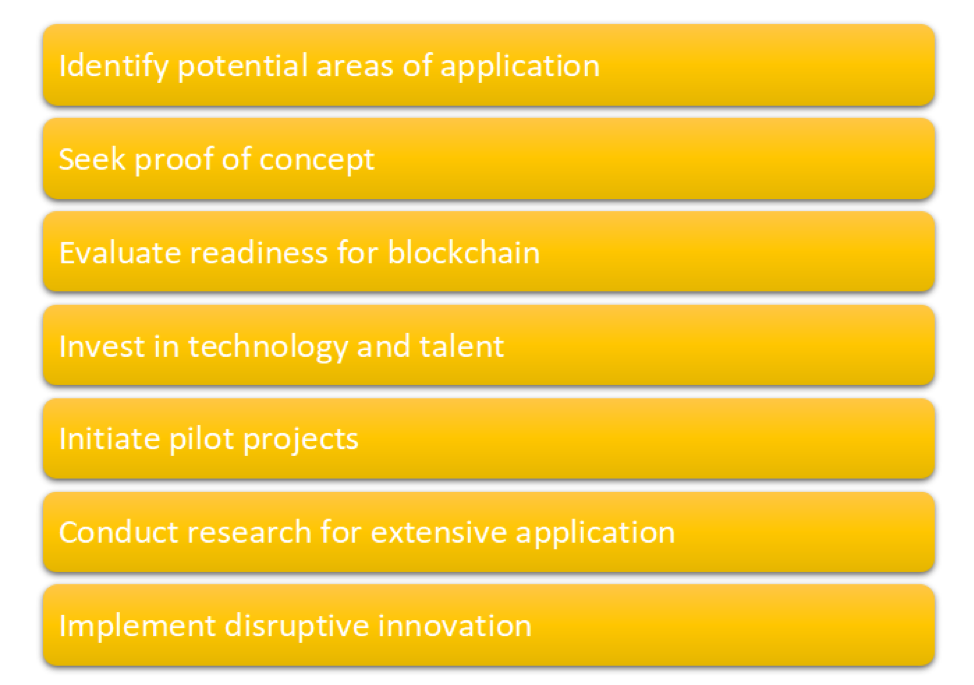• Application of blockchain in healthcare and life sciences should be seen as a continuous long-term endeavor to ensure a steady and stable integration.
by Naveen Joshi, Founder and CEO of Allerin

Healthcare and life sciences organizations need to deal with large amounts of complex data, most of which deals with human life. This necessitates accuracy and security in data storage and sharing. Blockchain technology, due to its reliability in handling such information, becomes an obvious choice for improving data handling in this industry. Redesigning the enterprise architecture to incorporate blockchain in healthcare and life science organizations can revolutionize the way patients are treated. However, following a roadmap that progressively builds up to a seamlessly integrated, potentially disruptive, healthcare business model. Following are the steps a healthcare CIO can oversee to ensure a steady, assured ascent to blockchain-enabled disruption.
Identify potential areas of application
Considering the hype surrounding blockchain and the potential industry-changing impact it can have, it is easy to get caught up and rush into using blockchain technology for the most obvious applications. However, it is important to thoroughly consider the organizational functions that could significantly benefit from blockchain, and the return on investment that could be expected for each application. Maintaining patients’ health records, monitoring the medicine and equipment inventory, handling billing and payments, verifying and disbursing insurance, and keeping track of clinical trial results are some of the areas where blockchain can be applied. Awareness and extensive knowledge of blockchain, along with practical creativity, can help devise novel ways for using blockchain in healthcare and life sciences.
Seek proof of concept
The rapid rate of blockchain evolution, along with a lack of complete understanding, makes it risky to conceive and directly implement novel blockchain applications. Thus, it is necessary to look for and analyze proof of concept and well researched use cases in healthcare before planning blockchain implementation in this field. Use cases for blockchain that are radically novel must be subjected to circumspect scrutiny and then eased into execution to avoid failure and non-profitable outcomes. Special focus should be on healthcare institutions that are already implementing some form of blockchain application.
Evaluate readiness for blockchain
Having finalized the areas for initial application and verifying the feasibility through a proof of concept, the next stage is to analyze the organizational requirements for effective implementation. This should include assessing the technological capabilities, resources, and capital, that would be required to introduce blockchain for the planned functions. The organization’s ability to meet these requirements must be considered and steps must be planned to close the identified gaps, if any.
Invest in technology and talent
The organization must invest in technological infrastructure that would not only allow implementation of the proposed blockchain applications, but also accommodate future technological additions. Similarly, blockchain experts, preferably from the healthcare industry, must be hired and the existing workforce must be trained to understand and utilize blockchain-powered technology. Long-term research should also be initiated to extend the capabilities of blockchain in the organization.
Initiate pilot projects
With proper groundwork in place, pilot projects in non-critical units must be planned and initiated. This could include patient billing, tracking medicine and drug usage, and other applications that would not halt the operations. A few leading healthcare companies are already in this phase and have planned pilot projects using blockchain to cut costs and improve data sharing. Pilots can also be conducted in life sciences to track and verify trial results and other data. Projects that justify the cost should be brought into regular execution and the applications should be constantly assessed, redesigned, and extended throughout the organization.
Conduct research for extensive application
Continuous research in expanding the capabilities of the blockchain foundation must be conducted and increasingly penetrative applications should be developed. At this stage, most units in the organization must be running on some form of blockchain technology, with considerable benefits. The research should now be be focused on radical, disruptive application of blockchain that would require a design thinking approach and integration with the Internet of Things, which would involve a massive overhaul of the healthcare delivery system.
Implement disruptive innovation
After considerable research, acquisition of technology, development of talent, and visible evidence of blockchain effectiveness within the organization, as well as, in the healthcare industry, the healthcare delivery process can be re-engineered in conjunction with IoT and made substantially lean and effective in providing healthcare. Making a radical change in any industry comes with a lot of uncertainty and risk, which could be managed through rationally planned and progressively penetrative implementation. This is especially the case in healthcare, as there is much more at stake than business performance. With IoT already making an impact on the healthcare industry, it is essential to consider IoT as a complementary tool for future application of blockchain in health and life sciences.

























